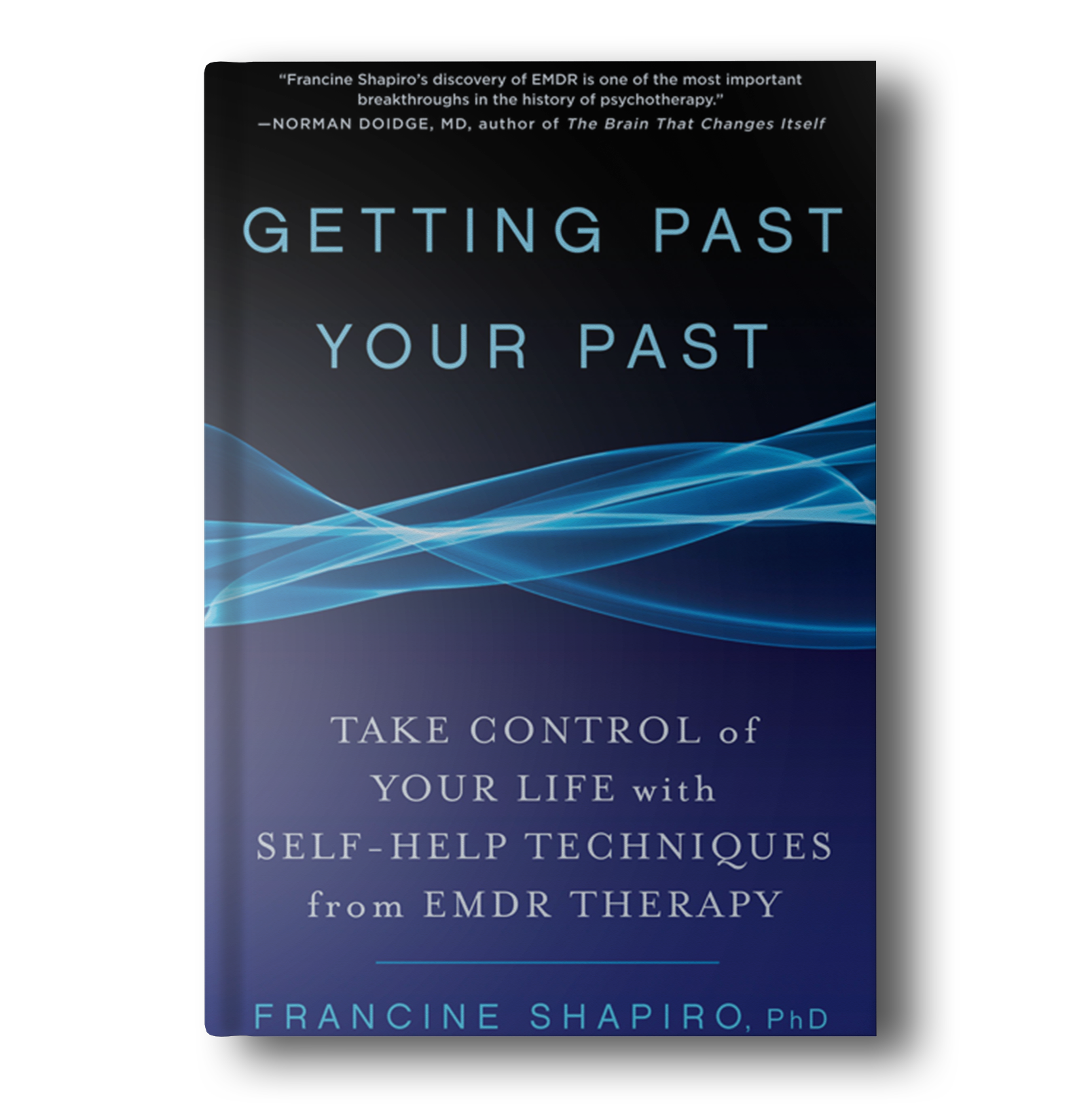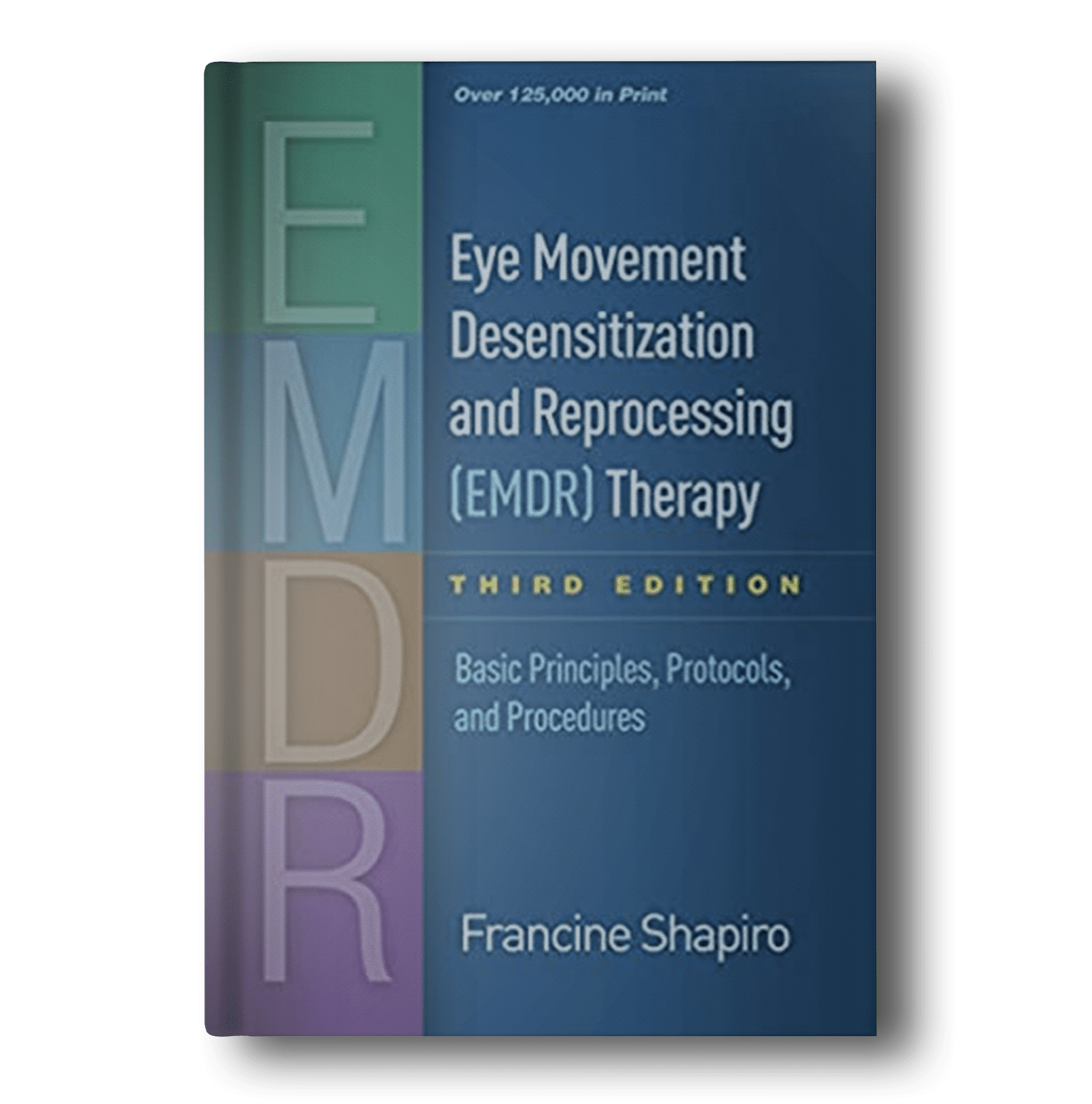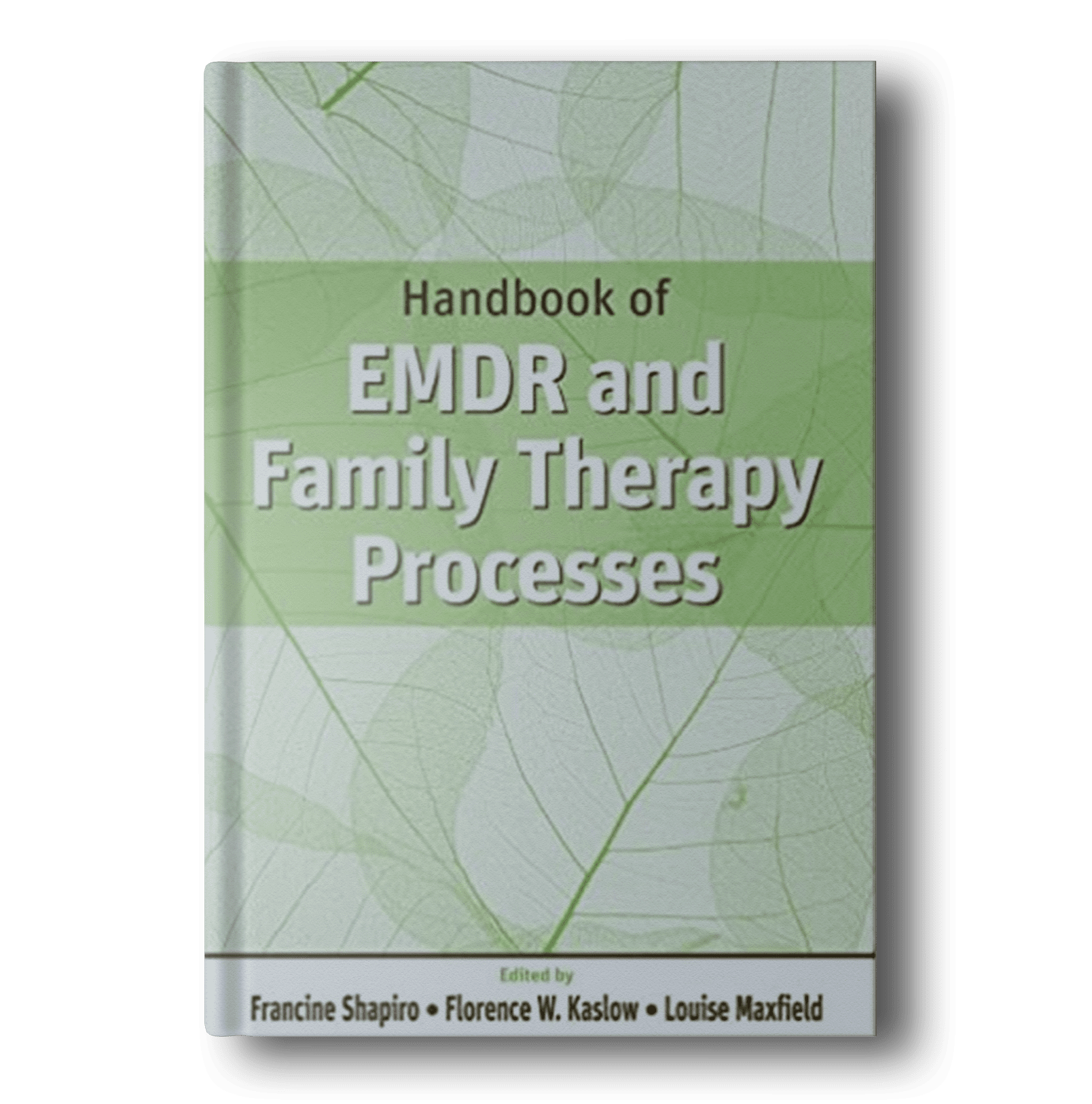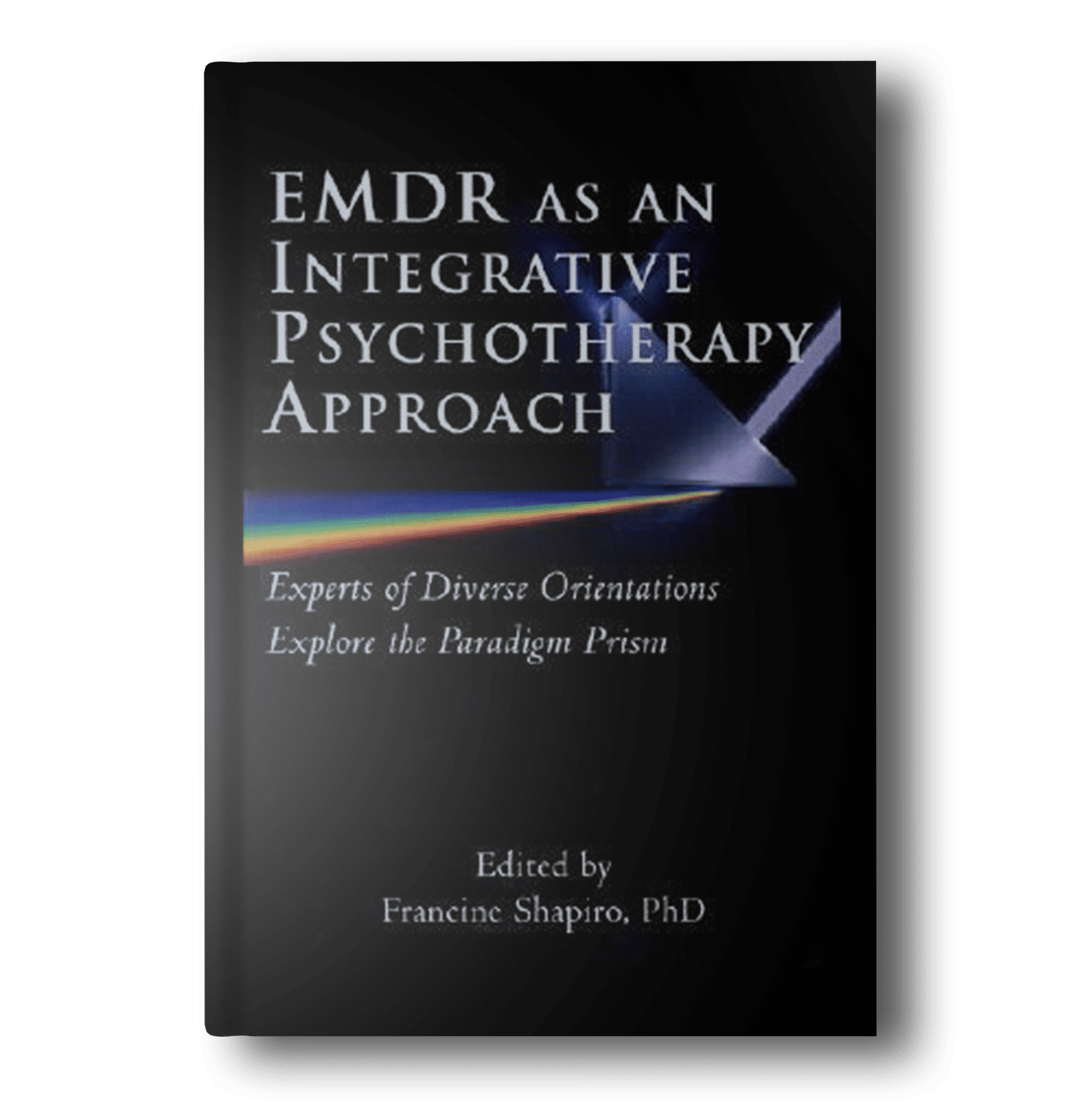EMDR: A Revolutionary Approach to Healing
Discover the transformative power of Eye Movement Desensitization and Reprocessing, pioneered by Dr. Francine Shapiro.

A Glimpse into EMDR
Eye Movement Desensitization and Reprocessing (EMDR) is a psychotherapy treatment that was originally designed to alleviate the distress associated with traumatic memories (Shapiro, 1989a, 1989b)
Shapiro’s (2001) Adaptive Information Processing model posits that EMDR therapy facilitates the accessing and processing of traumatic memories and other adverse life experience to bring these to an adaptive resolution. After successful treatment with EMDR therapy, affective distress is relieved, negative beliefs are reformulated, and physiological arousal is reduced.
During EMDR therapy, the client attends to emotionally disturbing material in brief sequential doses while simultaneously focusing on an external stimulus. Therapist directed lateral eye movements are the most commonly used external stimulus but a variety of other stimuli including hand-tapping and audio stimulation are often used (Shapiro, 1991).
Shapiro (1995, 2001) hypothesizes that EMDR therapy facilitates the accessing of the traumatic memory network, so that information processing is enhanced, with new associations forged between the traumatic memory and more adaptive memories or information. These new associations are thought to result in complete information processing, new learning, elimination of emotional distress, and development of cognitive insights.
EMDR & PTSD
EMDR therapy uses a three pronged protocol
1
the past events that have laid the groundwork for dysfunction are processed, forging new associative links with adaptive information
2
the current circumstances that elicit distress are targeted, and internal and external triggers are desensitized
3
imaginal templates of future events are incorporated, to assist the client in acquiring the skills needed for adaptive functioning
The Brain's Natural Healing Mechanism
Repeated studies show that by using EMDR therapy people can experience the benefits of psychotherapy that once took years to make a difference. It is widely assumed that severe emotional pain requires a long time to heal. EMDR therapy shows that the mind can in fact heal from psychological trauma much as the body recovers from physical trauma. When you cut your hand, your body works to close the wound. If a foreign object or repeated injury irritates the wound, it festers and causes pain. Once the block is removed, healing resumes.
EMDR therapy demonstrates that a similar sequence of events occurs with mental processes. The brain’s information processing system naturally moves toward mental health. If the system is blocked or imbalanced by the impact of a disturbing event, the emotional wound festers and can cause intense suffering. Once the block is removed, healing resumes.
Using the detailed protocols and procedures learned in EMDR therapy training sessions, clinicians help clients activate their natural healing processes.


The Visionary Behind EMDR
Francine Shapiro, Ph.D., is the originator and developer of EMDR, which has been so well researched that it is now recommended as an effective treatment for trauma in the Practice Guidelines of the American Psychiatric Association, and those of the Departments of Defense and Veterans Affairs. Dr. Shapiro is a Senior Research Fellow Emeritus at the Mental Research Institute in Palo Alto, California, Executive Director of the EMDR Institute in Watsonville, CA, and founder and President Emeritus of the Trauma Recovery EMDR Humanitarian Assistance Programs, a non-profit organization that coordinates disaster response and low fee trainings worldwide.
Transformations Through EMDR
Real-life testimonials and case studies showcasing the impact of EMDR on individuals' lives.
EMDR at a Glance
For Clinicians:
Eye Movement Desensitization and Reprocessing (EMDR) is a psychotherapy treatment that was originally designed to alleviate the distress associated with traumatic memories (Shapiro, 1989a, 1989b). Shapiro’s (2001) Adaptive Information Processing model posits that EMDR therapy facilitates the accessing and processing of traumatic memories and other adverse life experience to bring these to an adaptive resolution. After successful treatment with EMDR therapy, affective distress is relieved, negative beliefs are reformulated, and physiological arousal is reduced. During EMDR therapy the client attends to emotionally disturbing material in brief sequential doses while simultaneously focusing on an external stimulus. Therapist directed lateral eye movements are the most commonly used external stimulus but a variety of other stimuli including hand-tapping and audio stimulation are often used (Shapiro, 1991). Shapiro (1995, 2001) hypothesizes that EMDR therapy facilitates the accessing of the traumatic memory network, so that information processing is enhanced, with new associations forged between the traumatic memory and more adaptive memories or information. These new associations are thought to result in complete information processing, new learning, elimination of emotional distress, and development of cognitive insights. EMDR therapy uses a three-pronged protocol: (1) the past events that have laid the groundwork for dysfunction are processed, forging new associative links with adaptive information; (2) the current circumstances that elicit distress are targeted, and internal and external triggers are desensitized; (3) imaginal templates of future events are incorporated, to assist the client in acquiring the skills needed for adaptive functioning.
For Laypeople:
EMDR (Eye Movement Desensitization and Reprocessing) is a psychotherapy that enables people to heal from the symptoms and emotional distress that are the result of disturbing life experiences. Repeated studies show that by using EMDR therapy people can experience the benefits of psychotherapy that once took years to make a difference. It is widely assumed that severe emotional pain requires a long time to heal. EMDR therapy shows that the mind can in fact heal from psychological trauma much as the body recovers from physical trauma. When you cut your hand, your body works to close the wound. If a foreign object or repeated injury irritates the wound, it festers and causes pain. Once the block is removed, healing resumes. EMDR therapy demonstrates that a similar sequence of events occurs with mental processes. The brain’s information processing system naturally moves toward mental health. If the system is blocked or imbalanced by the impact of a disturbing event, the emotional wound festers and can cause intense suffering. Once the block is removed, healing resumes. Using the detailed protocols and procedures learned in EMDR training sessions, clinicians help clients activate their natural healing processes.
More than thirty positive controlled outcome studies have been conducted on EMDR therapy. Some of the studies show that 84%-90% of single-trauma victims no longer have post-traumatic stress disorder after only three 90-minute sessions. Another study, funded by the HMO Kaiser Permanente, found that 100% of the single-trauma victims and 77% of multiple trauma victims no longer were diagnosed with PTSD after only six 50-minute sessions. In another study, 77% of combat veterans were free of PTSD in 12 sessions. There has been so much research on EMDR therapy that it is now recognized as an effective form of treatment for trauma and other disturbing experiences by organizations such as the American Psychiatric Association, the World Health Organization and the Department of Defense. Given the worldwide recognition as an effective treatment of trauma, you can easily see how EMDR therapy would be effective in treating the “everyday” memories that are the reason people have low self-esteem, feelings of powerlessness, and all the myriad problems that bring them in for therapy. Over 100,000 clinicians throughout the world use the therapy. Millions of people have been treated successfully over the past 25 years.
EMDR therapy is an eight-phase treatment. Eye movements (or other bilateral stimulation) are used during one part of the session. After the clinician has determined which memory to target first, he asks the client to hold different aspects of that event or thought in mind and to use his eyes to track the therapist’s hand as it moves back and forth across the client’s field of vision. As this happens, for reasons believed by a Harvard researcher to be connected with the biological mechanisms involved in Rapid Eye Movement (REM) sleep, internal associations arise and the clients begin to process the memory and disturbing feelings. In successful EMDR therapy, the meaning of painful events is transformed on an emotional level. For instance, a rape victim shifts from feeling horror and self-disgust to holding the firm belief that, “I survived it and I am strong.” Unlike talk therapy, the insights clients gain in EMDR therapy result not so much from clinician interpretation, but from the client’s own accelerated intellectual and emotional processes. The net effect is that clients conclude EMDR therapy feeling empowered by the very experiences that once debased them. Their wounds have not just closed, they have transformed. As a natural outcome of the EMDR therapeutic process, the clients’ thoughts, feelings and behavior are all robust indicators of emotional health and resolution—all without speaking in detail or doing homework used in other therapies.
Treatment Description:
EMDR therapy combines different elements to maximize treatment effects. A full description of the theory, sequence of treatment, and research on protocols and active mechanisms can be found in F. Shapiro (2018) Eye movement desensitization and reprocessing: Basic principles, protocols and procedures (3rd edition) New York: Guilford Press.
EMDR therapy involves attention to three time periods: the past, present, and future. Focus is given to past disturbing memories and related events. Also, it is given to current situations that cause distress, and to developing the skills and attitudes needed for positive future actions. With EMDR therapy, these items are addressed using an eight-phase treatment approach.
Phase 1: The first phase is a history-taking session(s). The therapist assesses the client’s readiness and develops a treatment plan. Client and therapist identify possible targets for EMDR processing. These include distressing memories and current situations that cause emotional distress. Other targets may include related incidents in the past. Emphasis is placed on the development of specific skills and behaviors that will be needed by the client in future situations.
Initial EMDR processing may be directed to childhood events rather than to adult onset stressors or the identified critical incident if the client had a problematic childhood. Clients generally gain insight on their situations, the emotional distress resolves and they start to change their behaviors. The length of treatment depends upon the number of traumas and the age of PTSD onset. Generally, those with single event adult onset trauma can be successfully treated in under 5 hours. Multiple trauma victims may require a longer treatment time.
Phase 2: During the second phase of treatment, the therapist ensures that the client has several different ways of handling emotional distress. The therapist may teach the client a variety of imagery and stress reduction techniques the client can use during and between sessions. A goal of EMDR therapy is to produce rapid and effective change while the client maintains equilibrium during and between sessions.
Phases 3-6: In phases three to six, a target is identified and processed using EMDR therapy procedures. These involve the client identifying three things:
1. The vivid visual image related to the memory
2. A negative belief about self
3. Related emotions and body sensations.
In addition, the client identifies a positive belief. The therapist helps the client rate the positive belief as well as the intensity of the negative emotions. After this, the client is instructed to focus on the image, negative thought, and body sensations while simultaneously engaging in EMDR processing using sets of bilateral stimulation. These sets may include eye movements, taps, or tones. The type and length of these sets is different for each client. At this point, the EMDR client is instructed to just notice whatever spontaneously happens.
After each set of stimulation, the clinician instructs the client to let his/her mind go blank and to notice whatever thought, feeling, image, memory, or sensation comes to mind. Depending upon the client’s report, the clinician will choose the next focus of attention. These repeated sets with directed focused attention occur numerous times throughout the session. If the client becomes distressed or has difficulty in progressing, the therapist follows established procedures to help the client get back on track.
When the client reports no distress related to the targeted memory, (s)he is asked to think of the preferred positive belief that was identified at the beginning of the session. At this time, the client may adjust the positive belief if necessary, and then focus on it during the next set of distressing events.
Phase 7: In phase seven, closure, the therapist asks the client to keep a log during the week. The log should document any related material that may arise. It serves to remind the client of the self-calming activities that were mastered in phase two.
Phase 8: The next session begins with phase eight. Phase eight consists of examining the progress made thus far. The EMDR treatment processes all related historical events, current incidents that elicit distress, and future events that will require different responses.
EMDR therapy is recognized as an effective trauma treatment and recommended worldwide in the practice guidelines of both domestic and international organizations:
American Psychiatric Association (2004). Practice Guideline for the Treatment of Patients with Acute Stress Disorder and Posttraumatic Stress Disorder. Arlington, VA: American Psychiatric Association Practice Guidelines.
EMDR is recommended as an effective treatment for trauma.
Bleich, A., Kotler, M., Kutz, I., & Shalev, A. (2002). A position paper of the (Israeli) National Council for Mental Health: Guidelines for the assessment and professional intervention with terror victims in the hospital and in the community. Jerusalem, Israel.
EMDR is one of three methods recommended for treatment of terror victims.
California Evidence-Based Clearinghouse for Child Welfare (2010). Trauma Treatment for Children: http://www.cebc4cw.org.
EMDR and Trauma-focused CBT are considered “Well-Supported by Research Evidence.”
Chambless, D.L. et al. (1998). Update of empirically validated therapies, II. The Clinical Psychologist, 51, 3-16.
According to a taskforce of the Clinical Division of the American Psychological Association, the only methods empirically supported (“probably efficacious”) for the treatment of any post-traumatic stress disorder population were EMDR, exposure therapy, and stress inoculation therapy. Note that this evaluation does not cover the last decade of research.
CREST (2003). The management of post traumatic stress disorder in adults. A publication of the Clinical Resource Efficiency Support Team of the Northern Ireland Department of Health, Social Services and Public Safety, Belfast.
EMDR and CBT were stated to be the treatments of choice.
Department of Veterans Affairs & Department of Defense (2017). VA/DoD Clinical Practice Guideline for the Management of Post-Traumatic Stress. Washington, DC: Veterans Health Administration, Department of Veterans Affairs and Health Affairs, Department of Defense.
EMDR was given the highest level of recommendation and placed in the category of three “trauma-focused psychotherapies with the strongest evidence from clinical trials. This “A” category is described as “A strong recommendation that clinicians provide the intervention to eligible patients. Good evidence was found that the intervention improves important health outcomes and concludes that benefits substantially outweigh harm.”
Dutch National Steering Committee Guidelines Mental Health Care (2003). Multidisciplinary Guideline Anxiety Disorders. Quality Institute Heath Care CBO/Trimbos Intitute. Utrecht, Netherlands.
EMDR and CBT both designated as treatments of choice for PTSD.
Foa, E.B., Keane, T.M., Friedman, M.J., & Cohen, J.A. (2009). Effective treatments for PTSD: Practice Guidelines of the International Society for Traumatic Stress Studies New York: Guilford Press.
EMDR was listed as an effective and empirically supported treatment for PTSD, and was given an AHCPR “A” rating for adult PTSD. This guideline specifically rejected the findings of the previous Institute of Medicine report, which stated that more research was needed to judge EMDR effective for adult PTSD. With regard to the application of EMDR to children, an AHCPR rating of Level B was assigned. Since the time of this publication, three additional randomized studies on EMDR have been completed (see below).
INSERM (2004). Psychotherapy: An evaluation of three approaches. French National Institute of Health and Medical Research, Paris, France.
EMDR and CBT were stated to be the treatments of choice for trauma victims.
National Collaborating Centre for Mental Health (2005). Post traumatic stress disorder (PTSD): The management of adults and children in primary and secondary care. London: National Institute for Clinical Excellence.
Trauma-focused CBT and EMDR were stated to be empirically supported treatments for choice for adult PTSD.
SAMHSA’s National Registry of Evidence-based Programs and Practices (2011): http://nrepp.samhsa.gov/ViewIntervention.aspx?id=199
The Substance Abuse and Mental Health Services Administration (SAMHSA) is an agency of the U.S. Department of Health and Human Services (HHS). This national registry (NREPP) cites EMDR as evidence based practice for treatment of PTSD, anxiety, and depression symptoms. Their review of the evidence also indicated that EMDR leads to an improvement in mental health functioning.
Therapy Advisor (2004-11): http://www.therapyadvisor.com
An NIMH sponsored website listing empirically supported methods for a variety of disorders. EMDR is one of three treatments listed for PTSD.
United Kingdom Department of Health (2001). Treatment choice in psychological therapies and counselling evidence based clinical practice guideline. London, England.
Best evidence of efficacy was reported for EMDR, exposure, and stress inoculation.
World Health Organization (2013). Guidelines for the management of conditions that are specifically related to stress. Geneva, WHO.
Trauma-focused CBT and EMDR are the only psychotherapies recommended for children, adolescents and adults with PTSD. “Like CBT with a trauma focus, EMDR therapy aims to reduce subjective distress and strengthen adaptive cognitions related to the traumatic event. Unlike CBT with a trauma focus, EMDR does not involve (a) detailed descriptions of the event, (b) direct challenging of beliefs, (c) extended exposure, or (d) homework.” (p.1).
International Society for Traumatic Stress Studies (2018) Practice Guidelines.
http://www.istss.org/treating-trauma/new-istss-prevention-and-treatment-guidelines.aspx
EMDR therapy was given a strong recommendation as an effective and empirically supported treatment for PTSD in children, adolescents and adults.
For an annotated list of research: Research Overview.
Twelve studies with PTSD populations assessed treatment maintenance by analyzing differences in outcome between post-treatment and follow-up. Follow-up times have varied and include periods of 3, 4, 9, 15 months, and 5 years after treatment. Treatment effects were maintained in eight of the nine studies with civilian participants; one study (Devilly & Spence, 1999) reported a trend for deterioration. Of the three studies with combat veteran participants only one (Carlson et al., 1998) provided a full course of treatment (12 sessions). This study found that treatment effects were maintained at 9 months. The other two studies provided limited treatment: Devilly, Spence and Rapee (1998) provided two sessions and moderate effects at post-test were not maintained at follow-up. Pitman et al. (1996) treated only two of multiple traumatic memories, and treatment effects were not maintained at 5 year follow-up (Macklin et al., 2000). It appears that the provision of limited treatment may be inadequate to fully treat the disorder, resulting in remission of the partial effects originally achieved.
There is much anecdotal information that EMDR therapy is effective in the treatment of specific phobias. Unfortunately, the research that has investigated EMDR treatment of phobias, panic disorder, and agoraphobia has failed to find strong empirical support for such applications. Although these results are due in part to methodological limitations in the various studies, it is also possible that EMDR therapy may not be consistently effective with these disorders. De Jongh, Ten Broeke, and Renssen (1999) suggest that since EMDR therapy is a treatment for distressing memories and related pathologies, it may be most effective in treating anxiety disorders which follow a traumatic experience (e.g., dog phobia after a dog bite), and less effective for those of unknown onset (e.g., snake phobia).
There have been several randomized clinical trials assessing EMDR treatment of spider phobia (Muris & Merckelbach, 1997; Muris, Merckelbach, van Haaften, & Nayer, 1997; Muris, Merkelbach, Holdrinet, & Sijsenaar, 1998). These studies indicated that EMDR was less effective than in vivo exposure therapy in eliminating the phobia. Methodological limitations of these studies include failure to use the full EMDR treatment protocol (see Shapiro, 1999) and confounding of effects, by using the exposure treatment protocol as the post-treatment assessment. When the full EMDR phobia protocol was used in case studies with medical and dental phobias (De Jongh et al., 1999; De Jongh, van den Oord, & Ten Broeke, 2002), good results were achieved. A randomized controlled trial (Doering et al., 2013) indicated that three sessions of EMDR therapy memory processing resulted in remission of dental phobia. “After 1 yr, 83.3% of the patients were in regular dental treatment (d = 3.20).”
Clinical utility is an important consideration in treatment selection. The application of in vivo exposure may be impractical for clinicians who do not have easy access to feared objects (e.g., spiders) in their office settings; some phobias are limited to specific events (e.g., thunderstorms) or places (e.g., bridges). EMDR therapy may be a more practical treatment than in vivo exposure, and the in vivo aspect can often be added as homework (De Jongh et al., 1999).
There have been three studies that investigated EMDR treatment of panic disorder with/out agoraphobia. The first two studies were preliminary (Feske & Goldstein, 1997;Goldstein & Feske, 1994) and provided a short course (six sessions) of treatment for panic disorder. The results were promising, but limited by the short course of treatment. Feske and Goldstein write, “Even 10 to 16 sessions of the most powerful treatments rarely result in a normalization of panic symptoms, especially when these are complicated by agoraphobia” (p. 1034). The EMDR therapy effects were generally maintained at follow-up. A third study (Goldstein et al., 2000) was conducted to assess the benefits of a longer treatment course. This study however changed the target population and treated agoraphobic patients. Participants suffering from Panic Disorder with Agoraphobia did not respond well to EMDR therapy. Goldstein (quoted in Shapiro, 2001) suggests that these participants needed more extensive preparation, than was provided in the study, to develop anxiety tolerance. The authors suggest that EMDR therapy may not be as effective as CBT in the treatment of panic disorder with/out agoraphobia; however no direct comparison studies have yet been conducted. A study (Faretta, 2013) compared 12 sessions of EMDR with CBT in the treatment of panic disorder with or without accompanying agoraphobia. The processing of etiological events, triggers and memory templates was accomplished in session without the use of treatment-specific homework. In contrast, the CBT group utilized in-session breathing and relaxation exercises plus imaginal exposure, and was assigned both relaxation and exposure homework. Both treatments demonstrated a substantial decrease in anxiety symptoms, intensity and frequency of panic attacks. EMDR resulted in significantly fewer panic attacks than CBT at posttest and follow-up.
No. A number of studies have found EMDR therapy superior in outcome to placebo treatments, and to treatments not specifically validated for PTSD. EMDR has outperformed active listening (Scheck et al., 1998), standard outpatient care consisting of individual cognitive, psychodynamic, or behavioural therapy in a Kaiser Permanente Hospital (Marcus et al., 1997), relaxation training with biofeedback (Carlson et al., 1998). EMDR therapy as been found to be relatively equivalent to CBT therapies in seven randomized clinical trials that compared the two approaches. Because the treatment effects are large and clinically meaningful, it can be concluded that EMDR therapy is not a placebo treatment. For example, in a meta-analysis of PTSD treatments, Van Etten and Taylor (1998), calculated the mean effect sizes on self-report measures for placebo and control conditions as 0. 43, for EMDR as 1.24, and for CBT as 1.27 (p. 135). Several studies (e.g., Thordarson et al., 2001) have measured the credibility of the treatments being provided, as a way to determine if EMDR therapy elicited more confidence from clients, thereby producing larger effects; no study found EMDR more or less credible. Because EMDR therapy is not more credible than these other therapies, it appears that the effects cannot be attributed to suggestion or a heightened placebo effect.
A standard treatment for anxiety disorders involves exposing clients to anxiety eliciting stimuli. It has sometimes been assumed that EMDR therapy uses exposure in this traditional manner and that this accounts for the effectiveness of EMDR therapy. Some reviewers have stated, “Had EMDR therapy been put forth simply as another variant of extant treatments, we suspect that much of the controversy over its efficacy and mechanisms of action could have been avoided” (Lohr, Lilienfeld, Tolin, & Herbert, 1999, p. 201). However such a perspective ignores important elements of the EMDR procedure that are antithetical to exposure theories; in other words, the theories predict that if these EMDR elements were used in exposure therapy, a diminished outcome would result (Rogers & Silver, 2002). These elements include frequent brief exposures, interrupted exposure, and free association. (1) Exposure theorists Foa and McNally (1996) write: “Because habituation is a gradual process, it is assumed that exposure must be prolonged to be effective. Prolonged exposure produces better outcome than does brief exposure, regardless of diagnosis” (p. 334). EMDR however uses extremely brief repeated exposures (i.e., 20-50 seconds). (2) Other theorists (Marks et al., 1998) state that exposure should be continual and uninterrupted: “Continuous stimulation in neurons and immune and endocrine cells tends to dampen responses, and intermittent stimulation tends to increase them” (p 324). EMDR, on the other hand, interrupts the internal attention repeatedly to ask “What do you get now?” (3) Exposure therapy is structured to inhibit avoidance (Lyons & Keane, 1989), and specifically prohibits the patient from reducing “his anxiety by changing the scene or moving it ahead quickly in time to skim over the most traumatic point” (p. 146) in order to achieve extinction of the anxiety. However, free association to whatever enters the person’s consciousness is an integral part of the EMDR process. Differences such as these have prompted exposure researchers to state: “In strict exposure therapy the use of many of [‘a host of EMDR-essential treatment components’] is considered contrary to theory. Previous information also found that therapists and patients prefer this procedure over the more direct exposure procedure” (Boudewyn and Hyer, 1996, p.192) A one session direct process analysis of the two therapies found significant differences in practices and subjective response (Rogers et al., 1999).
Clearly theories explicating exposure therapy fail to explain the treatment effects of EMDR, with its brief, interrupted exposures, and its elicitation of free association. In addition there appears to be a difference in treatment process. During exposure therapy clients generally experience long periods of high anxiety (Foa & McNally, 1996), while EMDR clients generally experience rapid reductions in SUD levels early in the session (Rogers et al., 1999). This difference suggests the possibility that EMDR therapy’s use of repeated short focused attention may invoke a different mechanism of action that that of exposure therapy with its continual long exposure.
Although eye movements are often considered its most distinctive element, EMDR therapy is not a simple procedure dominated by the use of eye movements. It is a complex psychotherapy, containing numerous components that are considered to contribute to treatment effects. Eye movements are used to engage the client’s attention to an external stimulus, while the client is simultaneously focusing on internal distressing material. Shapiro describes eye movements as “dual attention stimuli,” to identify the process in which the client attends to both external and internal stimuli. Therapist directed eye movements are the most commonly used dual attention stimulus but a variety of other stimuli including hand-tapping and auditory stimulation are often used. The use of such alternate stimuli has been an integral part of the EMDR protocol for more than 10 years (Shapiro 1991, 1993).
As with any form of psychotherapy, there may be a temporary increase in distress.
- distressing and unresolved memories may emerge
- some clients may experience reactions during a treatment session that neither they nor the administering clinician may have anticipated, including a high level of emotion or physical sensations
- subsequent to the treatment session, the processing of incidents/material may continue, and other dreams, memories feelings, etc., may emerge.
Each case is unique, but there is a standard eight phase approach that each clinician should follow. This includes taking a complete history, preparing the client, identifying targets and their components, actively processing the past, present and future aspects, and on-going evaluation. The processing of a target includes the use of dual stimulation (eye movements, taps, tones) while the client concentrates on various aspects. After each set of movements the client briefly describes to the clinician what s/he experienced. At the end of each session, the client should use the techniques s/he has been taught by the clinician in order to leave the session feeling in control and empowered. At the end of EMDR therapy, previously disturbing memories and present situations should no longer be problematic, and new healthy responses should be the norm. A full description of multiple cases is available in the book Getting Past Your Past: Take Control of Your Life with Self-Help Techniques from EMDR Therapy by Shapiro.
The number of sessions depends upon the specific problem and client history. However, repeated controlled studies have shown that a single trauma can be processed within 3 sessions in 80-90% of the participants. While every disturbing event need not be processed, the amount of therapy will depend upon the complexity of the history. In a controlled study, 80% of multiple civilian trauma victims no longer had PTSD after approximately 6 hours of treatment. A study of combat veterans reported that after 12 sessions 77% no longer had post-traumatic stress disorder.
This depends upon the client’s ability to “self-soothe” and use a variety of self-control techniques to decrease potential disturbance. The clinician should teach the client these techniques during the preparation phase. The amount of preparation needed will vary from client to client. In the majority of instances the active processing of memories should begin after one or two sessions.
Two studies have indicated that EMDR therapy has provided positive treatment effects to traumatized psychotic patients (de Bont, van Minnen, & de Jongh, 2013; . van den Berg, & van den Gaag, 2012). In the second study, treatment of PTSD has a positive effect on auditory verbal hallucinations, delusions, anxiety symptoms, depression symptoms, and self-esteem. Individuals with schizophrenia may have experienced distressing life experiences or traumas that exacerbate their symptoms. Using EMDR therapy to process memories of such events may be helpful in alleviating stress and reducing symptoms. In such cases, it would be assumed that treatment would be provided only after appropriate stabilization, and in the hands of an expert in this specialty area. Anecdotal reports have given preliminary support for this. However, more research needs to be conducted.
The American Journal of Hypnosis published a special issue on the use of EMDR therapy and hypnosis. An introductory article by the editor and past president of the American Association of Clinical Hypnosis directly addressed the issue: “While it has been argued against categorizing hypnosis as a specific type of treatment method (e.g., Fischolz, 1995; 1997a; 1997b; 2000; Fischholz & Spiegel, 1983), this is not the case for EMDR. Like psychoanalysis, EMDR is both an evolving theory about how information is perceived, stored and retrieved in the human brain and a specific treatment method based on this theory (Shapiro, 1995, 2001). In fact, EMDR is a very unique treatment method, which like other types of treatment/methods/techniques (e.g. psychoanalytic/psychodynamic therapy, behavior, cognitive-behavioral therapy, ego-state therapy) can also be incorportated with hypnosis (Hammond, 1990).
We note there are some distinctive differences between hypnosis and EMDR therapy, which we would like to briefly highlight. First, one of the major uses of hypnosis among clinical practitioners is to deliberately begin by inducing in the patient an altered state of mental relaxation. In contrast, when beginning EMDR mental relaxation is not typically attempted. In fact, deliberate attempts are often actually made to connect with an anxious (i.e. an emotionally disturbing as opposed to relaxed) mental state.
Second, therapists often use hypnosis to help a patient develop a single, highly focused state of aroused receptivity (Spiegel & Spiegel, 1978). In contrast, with EMDR attempts are made to maintain a duality of focus on both positive and negative currently held self-referencing beliefs, as well as the emotional arousal brought about by imaging the worst part of a disturbing memory. However, in this sense, EMDR does have a similarity to Spiegel’s (Spiegel & Spiegel, 1978) split-screen cognitive restructuring technique.
Third, one of the proposed effects of hypnotizing a person is that they will have a decrease in their generalized reality orientation (GRO: Shor, 1979). This induced decrease in a person’s GRO is often utilized in order to promote an increase in fantasy and imagination, perhaps by capitalizing on an increase in trance logic (Orne, 1977). In contrast, in EMDR attempts are made towards repeatedly grounding the patient by referencing current feelings and body sensations to prevent the patient from drifting away from reality. Specific encouragement/inducement is made towards rejecting previously irrational/self-blaming beliefs in favor of a newly, reframed positive belief with an increase in subjective conviction about that belief. Shapiro and Forrest (1997) and Nicosia (1995) have also noted additional differences between hypnosis and EMDR.
There is no indication that EMDR therapy will increase the frequency of seizures.
As with any form of psychotherapy, there may be a temporary increase in distress.
- distressing and unresolved memories may emerge
- some clients may experience reactions during a treatment session that neither they nor the administrating clinician may have anticipated, including a high level of emotion or physical sensation
- subsequent to the treatment session, the processing of incidents/material may continue, and other dreams, memories, feelings, etc., may emerge.




